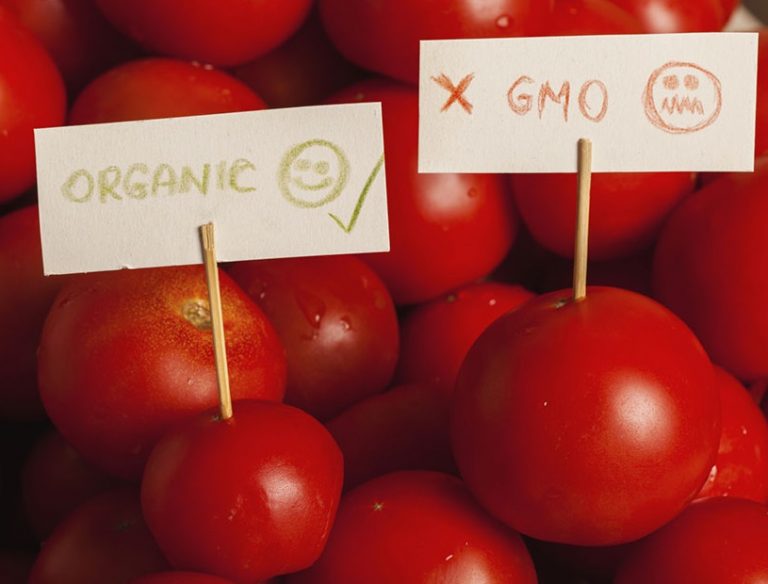
Why did the Organic Trade Association, which says its mission is to promote and protect organic, support measures against GMO labeling? Why is the OTA increasingly succumbing to influential corporate members that seemingly do not belong?
For many Americans, the organic label on a food represents a superior product, one that’s free from pesticides and other agricultural chemicals and farmed using sustainable agricultural practices. Many would be surprised to learn, however, that in many cases organic companies are owned by multinational conglomerates, many of which produce nonorganic foods as well, using methods that are in direct contrast to the rules of organic.
Such discrepancies have become even more apparent when you look at trade groups like the Organic Trade Association (OTA), which says its mission is to promote and protect organic — and its members work together toward this end. “OTA members represent the huge diversity and the entire supply chain of today’s organic industry — small and large organic farmers of all types, local and national organic processors, regional and countrywide organic distributors, mom-and-pop organic stores and organic retail chains,” according to OTA.1
But hiding (in plain sight) among these wholesome ranks are corporate members that seemingly do not belong, like chemical giant BASF, one of the largest manufacturers of dicamba-based herbicideformulations and a major player in genetically modified organisms (GMOs), and agricultural conglomerate Cargill, another GMO and concentrated animal feeding operation (CAFO) giant. Cargill even goes so far as to praise the virtues of factory farming, stating, “CAFOs are effective and efficient, as well as being a more sustainable means of resource utilization.”2
The apparent conflict between promoting organic standards while at the same time accepting members who blatantly ignore them for most of their products has led to tension among some OTA members, even causing one family-owned organic farm, Nature’s Path, to depart the organization after nearly 20 years of involvement.
“Our departure from the OTA is an act of protest to raise awareness of our concern that the important role organic plays to support the health of consumers and our planet is being compromised,” Arran Stephens, Nature’s Path cofounder and CEO, told Living Maxwell.3
OTA Betrays Consumers by Supporting the DARK Act
Some of Nature’s Path’s discontent with OTA started in the 1990s. Stephens once served on OTA’s board of directors but resigned when he felt the organization was not doing enough to combat GMOs. Indeed, in 2016, OTA seemingly sold out and supported H.R. 1599, a bill colloquially known as the DARK Act (Deny Americans the Right to Know). It revoked states’ right to impose mandatory labeling of GMOs, making Vermont’s state law for mandatory GMO labeling, which had taken effect July 1, 2016, null and void.
In its place, the federal law replaced clear GMO labeling with quick response (QR) codes which, when scanned with your smartphone will bring you to the company’s website, where you may or may not find information about the presence of genetically engineered (GE) ingredients.
The companies that convinced the OTA to support the DARK Act and its current iteration are nonorganic junk food brands that happen to own organic brands. Their main concern is not protecting organics but, rather, exploiting the organic niche while continuing to peddle their GMO-laden wares. Dag Falck, the organic program manager for Nature’s Path, served on OTA’s board in 2016 but resigned due to their handling of the DARK Act. He told Living Maxwell:
“This was such an enormous issue that the entire membership should have been asked, but they weren’t. As a board member and a member of the executive committee, I was never asked to take a vote on the issue of OTA supporting the mandatory federal labeling of GMOs. Instead, the OTA President and the Executive Director made the decision on their own, and we found out after the fact.”4
OTA Member BASF Continues to Devastate the Environment With Dicamba
In 2017, BASF released Engenia, a dicamba-based herbicide designed specifically for use with GE dicamba-tolerant soybeans and cotton. That year, they announced a more than $270-million investment to expand production capacity for the herbicide in Texas; it was the company’s largest investment ever in facilities for agricultural products.5 BASF’s production and expansion of dicamba has no place in the organic movement, and this product is even mired in controversy among conventional farmers because the drift-prone formulations are damaging neighboring crops.
By November 2017, an estimated 3.6 million acres across the U.S. had been damaged by dicamba drift,6 as had trees in Iowa, Illinois and Tennessee. In response, the U.S. Environmental Protection Agency (EPA) placed some restrictions on dicamba usage, making it more cumbersome for farmers. For instance, special training is required to apply the herbicide, and its application is prohibited when wind speeds are greater than 10 mph. Farmers are also asked to assess the risk that spraying could have on nearby crops, as well.
Despite this, reports of damage from dicamba drift have continued in 2018, including 25,000 acres of soybean damage in one area of Missouri alone. Some farmers feel they’re being forced to buy GE dicamba-tolerant seeds, just so they can survive their neighbors’ chemical sprays.7 The Center for Biological Diversity also estimated that dicamba is slated to be sprayed on more than 60 million acres of monarch butterfly habitat, even though it’s toxic to milkweed, their only food.
“America’s monarchs are already in serious trouble, and this will push them into absolute crisis,” said Nathan Donley, a senior scientist at the Center, in a news release. “It’s appalling that the EPA approved this spraying without bothering to consider the permanent damage it will do to these butterflies and their migration routes.”8
BASF Wants to Market Organic Mulch Made With GMOs
While turning a blind eye to the environmental destruction caused by dicamba, BASF is also attempting to get organic approval for a biodegradable mulch product being made by its biopolymers division. The mulch is made using GMOs as a “processing aid,” which should automatically disqualify the product from organic certification, since GMOs are not allowed in organics.
However, BASF is claiming that the GMOs “do not survive the production process” and using that loophole to gain approval from the National Organic Standards Board (NOSB). According to Living Maxwell, NOSB board member David Mortensen, Ph.D., professor of weed and applied plant ecology at Penn State University, told the business development manager for BASF’s biopolymers division:9
“I was coming back from the dicamba drift discussion, a closed-door discussion, where I heard multiple organic farmers say that they’re on the verge of not being able to grow their crops because of dicamba drift, which is manufactured by BASF. I guess I’m trying to reconcile a corporate ethic that wants to sell a product for organic production on the one hand and is selling a product that’s being used on about 50 million acres of cropland on the other hand. Could you just help me see the corporate ethic where there’s consistency here?”
OTA Member Cargill Is Synonymous With CAFOs and GMOs
Nature’s Path also cited OTA member Cargill as another reason to part ways with OTA. “Cargill is one of a handful of global players that are driving the factory farm model of food production. Cargill is also intimately involved in the production of cheap GMO soy that is one of the top feed sources for factory farmed livestock and fish,” Patty Lovera, policy director for Food & Water Watch, told Living Maxwell.10
Cargill has also partnered with BASF to create GE canola seeds that produce plant-based omega-3, even though GE canola commonly contaminates organic farms. It’s an unsettling irony that Cargill, a company that operates using CAFOs, GMOs and toxic pesticides, also sells organic sunflower and soybean oil, as though they’re interested in organic farming.
Stephens, the Nature’s Path executive, cited Cargill, BASF and other OTA members like Kellogg, General Mills and Smuckers as those who have spent millions of dollars to fight GMO labeling and transparency. Yet, when he complained about their OTA membership, specifically for BASF, he didn’t receive a suitable response.11
OTA’s Acceptance of Hydroponic ‘Container Growing Systems’ Is Highly Controversial
OTA and the hydroponic lobby, led by the Coalition for Sustainable Organics, are seeking to rewrite organic rules to include hydroponics, which are plants grown in a liquid medium without soil. However, U.S. Department of Agriculture (USDA) organic regulations require that your crop rotation plan maintains or improves soil organic matter.
Since hydroponics do not involve the use of soil, they do not qualify for organic certification, yet hydroponic operators have been certified organic by USDA accredited certification agencies, which is deceitful to the public. Hydroponics also use chemicals, which organic producers are barred from using. Worse, commercial hydroponic growers will rarely reveal the fertilizers they use.
Further, keep in mind that while growing food indoors does reduce the need for pesticides, it does not automatically mean hydroponic vegetables are pesticide-free. In addition, at least one study found hydroponically grown vegetables had lower levels of carotenoids such as beta-carotene and lutein than conventional vegetables.12
While OTA claims that they are not in favor of hydroponics, they support the allowance of container growing systems, which are those grown in mediums such as coconut fiber with liquid nutrients added. Companies such as Driscoll’s and Wholesum Harvest, also OTA members, claim to use container growing systems, but many say they are actually one in the same as hydroponics because most of the nutrients are delivered via a liquid solution.13
Organic Factory Farms Become the Norm
Unfortunately, an organic label on your food is not necessarily enough to verify that it comes from a farm using humane, sustainable practices. In the dairy industry, for instance, some organic farms are passing off industrially produced milk as organic — and pocketing the increased profits while small family farms struggle to survive. Cows produce more milk, faster, when they’re fed grain in the barn, as opposed to grazing on grass on pasture.
Industrialized organic dairies are capitalizing on this by skimping on grazing time, raising thousands of cows in veritable CAFOs, yet still gaining the USDA organic label that suggests a superior product. In fact, thousands of chickens could be raised in squalid conditions on a CAFO, yet still be labeled as organic.14 In April 2016, the USDA’s Agricultural Marketing Service (AMS) issued a proposed rule to amend organic livestock and poultry practices to provide for better animal welfare.
A final rule was published in January 2017, delayed multiple times until November and then finally withdrawn in May 2018.15 In short, some organic companies continue to operate as CAFOs, raising animals in confinement and producing sub-par “organics” that taint the entire system. If you want to know who really owns the organic brands you trust and love, check out the Cornucopia Institute’s Who Owns Organic graphic16 — but be prepared, you’re probably in for some surprises.
The Solution? Biodynamic Produce and AGA-Certified Beef and Dairy
There are many organic companies that are doing it right, raising “clean” meats and pesticide-free produce using traditional, chemical-free farming methods that support surrounding ecosystems and laws of nature. However, many are not, and it’s not always easy to decipher the good guys from the bad. Biodynamic farming is a welcome alternative that goes beyond organic in some key ways.
Biodynamic farming is organic, regenerative farming, taking advantage of crop rotation, cover crops and so on, but it goes a step further, taking moon phases and planetary cycles into account when planting and harvesting, for example. Biodynamic farming also differs a bit in the way farmers are certified. While an organic farmer can section off as little as 10 percent of the farm for the growing of certified organic goods, in order to be certified as a biodynamic farmer, your entire farm must be biodynamic.
In addition to that, biodynamic certification also requires 10 percent of the land be dedicated to increasing biodiversity, such as forest, wetland or insectary. Not only does biodynamic farming provide superior crops both in volume and increased density of nutrients, but biodynamic farms are also completely self-sustaining.
For meat and dairy, because the USDA is not doing nearly enough to protect the integrity of its organic label, I encourage you to look for the American Grassfed Association (AGA) logo, a high-quality grass fed standards and certification for American-grown grass fed meat and dairy.17
The standard allows for greater transparency and conformity18 and is intended to ensure the humane treatment of animals and meet consumer expectations about grass fed products, while being feasible for small farmers to achieve. An AGA logo on a product lets you know the animals were fed a lifetime diet of 100 percent forage, were raised on pasture (not in confinement) and were not treated with hormones or antibiotics.19
You can further protect your family by consulting Cornucopia’s organic dairy scorecard, which separates organic high-integrity dairy brands from what they call the “factory farm imposters.” The Cornucopia Institute’s Scrambled Eggs report and organic egg scorecard are also important resources, which rank 136 egg producers according to 28 organic criteria.
As demand for truly sustainable, high-quality food sources grow, it’s becoming easier to find biodynamic and AGA-certified foods at local health food stores, farmers markets and food co-ops; however, if you can’t find these, look for organic foods grown by small farmers you know and trust.
Biotech Companies are Gaining Power by Taking Over the Government
There is no doubt in my mind that GMOs and the toxic chemicals used along with them pose a serious threat to the environment and our health, yet government agencies turn a blind eye and refuse to act — and the reason is very clear: They are furthering the interests of the biotech giants.
It is well known that there is a revolving door between government agencies and biotech companies such as Monsanto. Consider the hypocrisy of the FDA. On paper, the U.S. may have the strictest food safety laws in the world governing new food additives, but this agency has repeatedly allowed GMOs and their accompanying pesticides such as Roundup to evade these laws.
In fact, the only legal basis for allowing GE foods to be marketed in the U.S. is the FDA’s claim that these foods are inherently safe, a claim which is patently ridiculous. Documents released as a result of a lawsuit against the FDA reveal that the agency’s own scientists warned their superiors about the detrimental risks of GE foods. But their warnings fell on deaf ears.
The influence of the biotech giants is not limited to the U.S. In a June 2017 article, GMWatch revealedthat 26 of the 34 members of the National Advisory Committee on Agricultural Biotechnology of Argentina (CONABIA) are either employed by chemical technology companies or have major conflicts of interest.
You may be aware that Argentina is one of the countries where single-crop fields of GE cotton, corn and soy dominate the countryside. Argentina is also a country facing severe environmental destruction. Argentinians are plagued with health issues, including degenerative diseases and physical deformities. It would appear that the rapid expansion of GE crops and the subsequent decline in national health indicators are intrinsically linked.
Don’t Be Duped by Industry Shills!
Biotech companies’ outrageous attempts to push for their corporate interests extend far beyond the halls of government. In a further effort to hoodwink the public, Monsanto and its cohorts are now zealously spoon-feeding scientists, academics and journalists with questionable studies that depict them in a positive light.
By hiring “third-party experts,” biotech companies are able to take information of dubious validity and present it as independent and authoritative. It’s a shameful practice that is far more common than anyone would like to think. One notorious example of this is Henry Miller, who was thoroughly outed as a Monsanto shill during the 2012 Proposition 37 GMO labeling campaign in California.
Miller, falsely posing as a Stanford professor, promoted GE foods during this campaign. In 2015, he published a paper in Forbes Magazine attacking the findings of the International Agency for Research on Cancer, a branch of the World Health Organization, after it classified glyphosate as a probable human carcinogen. After it was revealed that Miller’s work was in fact ghostwritten by Monsanto, Forbes not only fired him, but also removed all of his work from its site.
Industry front groups also abound. The Genetic Literacy Project and the American Council for Science and Health are both Monsanto-funded. Even WebMD, a website that is often presented as a trustworthy source of “independent and objective” health information, is acting as a lackey for Monsanto by using its influence to promote corporate-backed health strategies and products, displaying advertisements and advertorials on Biotech’s behalf, furthering the biotech industry’s agenda — all for the sake of profit.
Monsanto has adopted underhanded tactics to peddle its toxic products, but the company is unable to hide the truth: Genetic engineering will, in no way, shape or form, make the world a better place. It will not solve world hunger. It will not increase farmers’ livelihoods. And it will most certainly not do any good for your health — and may in fact prove to be detrimental.
There’s No Better Time to Act Than NOW — Here’s What You Can Do
So now the question is: Will you continue supporting the corrupt, toxic and unsustainable food system that Monsanto and its industry shills and profit-hungry lackeys have painstakingly crafted? It is largely up to all of us, as consumers, to loosen and break Monsanto’s tight hold on our food supply. The good news is that the tide has been turned.
As consumers worldwide become increasingly aware of the problems linked to GE crops and the toxic chemicals and pesticides used on them, more and more people are proactively refusing to eat these foods. There’s also strong growth in the global organic and grass fed sectors. This just proves one thing: We can make a difference if we steadily work toward the same goal.
One of the best things you can do is to buy your foods from a local farmer who runs a small business and uses diverse methods that promote regenerative agriculture. You can also join a community supported agriculture (CSA) program, where you can buy a “share” of the vegetables produced by the farm, so that you get a regular supply of fresh food. I believe that joining a CSA is a powerful investment not only in your own health, but in that of your local community and economy as well.
In addition, you should also adopt preventive strategies that can help reduce the toxic chemical pollution that assaults your body. I recommend visiting these trustworthy sites for non-GMO food resources in your country:
Monsanto and its allies want you to think that they control everything, but they do not. It’s you, the masses, who hold the power in your hands. Let’s all work together to topple the biotech industry’s house of cards. Remember — it all starts with shopping smart and making the best food purchases for you and your family.
- 1 Organic Trade Association, Member List
- 2 Cargill, Ethical Treatment
- 3, 4, 9, 10, 11, 13 Living Maxwell July 23, 2018
- 5 BASF U.S. March 21, 2017
- 6 New York Times November 1, 2017
- 7 NPR October 13, 2017
- 8 Center for Biological Diversity March 1, 2018
- 12 Journal of Agricultural Food Chemistry 2003; 51(9): 2603-2607
- 14 The Cornucopia Institute July 13, 2016
- 15 USDA, Organic Livestock and Poultry Practices
- 16 Cornucopia Institute, Who Owns Organic
- 17 American Grassfed December 21, 2016
- 18 Civil Eats January 4, 2017
- 19 American Grassfed, Become an Approved AGA Producer
Disclaimer: We at Prepare for Change (PFC) bring you information that is not offered by the mainstream news, and therefore may seem controversial. The opinions, views, statements, and/or information we present are not necessarily promoted, endorsed, espoused, or agreed to by Prepare for Change, its leadership Council, members, those who work with PFC, or those who read its content. However, they are hopefully provocative. Please use discernment! Use logical thinking, your own intuition and your own connection with Source, Spirit and Natural Laws to help you determine what is true and what is not. By sharing information and seeding dialogue, it is our goal to raise consciousness and awareness of higher truths to free us from enslavement of the matrix in this material realm.
 EN
EN FR
FR


























My local and Trader Joe’s scored poor on their dairy list